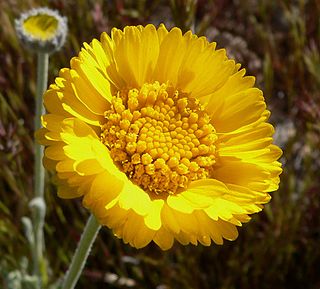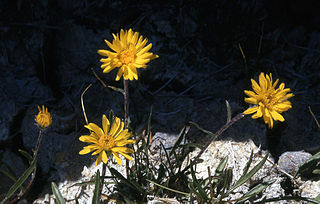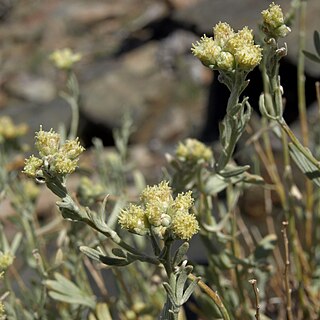
Baileya is a genus of plants in the aster family Asteraceae. All are native to the southwestern United States and to Mexico.

Baileya multiradiata is a North American species of sun-loving wildflower in the family Asteraceae. It is native to the deserts of northern Mexico and the Southwestern United States. It has been found in the States of Sonora, Chihuahua, Coahuila, Durango, Aguascalientes, California, Arizona, Nevada, Utah, New Mexico, and Texas.

Ericameria bloomeri, known by the common names Bloomer's rabbitbush and Bloomer's goldenbush, is a species of flowering shrub in the family Asteraceae. This plant is native to the mountains of western North America from British Columbia to California, including Washington, Oregon, Idaho, and Nevada. It may have been extirpated from Canada.

Ericameria cuneata is a species of flowering shrub in the family Asteraceae known by the common name cliff goldenbush. This plant is native to the southwestern United States and northwestern Mexico.
Hulsea californica is a rare species of flowering plant in the family Asteraceae known by the common names San Diego alpinegold and San Diego sunflower. It is endemic to southern California, where it grows only in the Peninsular Ranges.

Brickellia nevinii is a species of flowering plant in the family Asteraceae known by the common name Nevin's brickellbush. It is endemic to southern California, where it is an uncommon resident of desert and mountain scrub plant communities.

Chaenactis artemisiifolia, with the common name white pincushion, is a species of flowering plant in the daisy family. It is native to the coastal Peninsular Ranges of Southern California and Baja California, in the chaparral and woodlands.

Baileya pauciradiata is a species of flowering plant in the daisy family, Asteraceae. It is known by the common names laxflower and Colorado desert marigold. It is native to the deserts of northwestern Mexico and the southwestern United States. It has been found in the States of California, Arizona, Nevada, Baja California, and Sonora.

Brickellia incana is a North American species of flowering plant in the family Asteraceae known by the common name woolly brickellbush. It is native to the Mojave Desert and Sonoran Desert in the southwestern United States, in California, Nevada, and Arizona.

Eriophyllum mohavense, also known as the Mojave woolly sunflower or the Barstow woolly sunflower, is a rare species of small annual flowering plant in the family Asteraceae, found only (endemic) in the Mojave Desert of California.

Enceliopsis covillei, known by the common name Panamint daisy, is a rare North American desert species of flowering plant in the family Asteraceae.

Enceliopsis nudicaulis is a North American species of flowering plants in the family Asteraceae known by the common name nakedstem sunray, or naked-stemmed daisy.

Ericameria greenei is a species of flowering shrub in the family Asteraceae known by the common name Greene's goldenbush. It is native to the mountains of the western United States in Washington, Idaho, Oregon, and the northern California as far south as Lake and Tuolumne Counties.
Eriophyllum ambiguum is a species of flowering plant in the family Asteraceae known by the common name beautiful woolly sunflower. It is native to the deserts and adjacent hills of southern and eastern California, northwestern Arizona, and southern Nevada.
Eriophyllum jepsonii is a rare North American species of flowering plant in the family Asteraceae known by the common name Jepson's woolly sunflower. It is endemic to California, where it has been found in the Central Coast Ranges and adjacent hills from Contra Costa County to Ventura County.

Eriophyllum pringlei is a North American species of flowering plant in the family Asteraceae known by the common name Pringle's woolly sunflower. It is native to the southwestern United States and northern Mexico, where it grows in several types of desert, canyon, and hillside habitat, such as chaparral and sagebrush.

Lessingia lemmonii is a species of flowering plant in the family Asteraceae known by the common name Lemmon's lessingia. It is native to the western United States around the intersection of Nevada, Arizona, and California, where it grows in desert and other habitat with sandy soils. This is an annual herb producing gray-green woolly stems in a low clump just a few centimeters high to a relatively erect 40 centimeters tall. The leaves are narrow and small, under 2 centimeters long, with much larger leaves appearing around the base of the young plant and withering away early. The flower heads appear singly or in open arrays. Each head has a bell- to bullet-shaped involucre lined with hairy to woolly phyllaries. The head is discoid, containing no ray florets but many funnel-shaped yellow disc florets with long lobes. The florets often have white markings in the throats. The fruit is an achene with a whitish or brownish pappus of bristles.

Malacothrix coulteri is a species of flowering plant in the family Asteraceae. It is known by the common name snake's head or snake's head desert-dandelion.

Pyrrocoma uniflora is a species of flowering plant in the family Asteraceae known by the common name plantain goldenweed. It is native to western North America from central Canada to California to Colorado, where it grows in several types of habitat, including forest and meadows with alkali soils, such as those near hot springs. It is a perennial herb growing up to 40 centimeters tall, the stems reddish and usually with a thin to thick coating of woolly fibers. The lance-shaped, toothed leaves are usually woolly, the largest near the base of the plant reaching up to 12 centimeters in length. The inflorescence is a single flower head or a cluster of a few heads, each lined with woolly phyllaries. The head contains yellow disc and ray florets. The fruit is an achene which may be over a centimeter long including its long pappus.

Sphaeromeria cana is a species of flowering plant in the family Asteraceae known by the common name gray chickensage. It is native to the western United States, where it is known from the Sierra Nevada, the adjacent desert ranges of eastern California and Nevada, and Steens Mountain of Oregon. It grows in dry, rocky mountain habitat, such as cracks and crevices, including the talus above the tree line. This is an aromatic subshrub with numerous erect branches growing up to 30 to 60 centimeters tall. It is gray-green in color and coated with woolly fibers. The leaves are linear or lance-shaped, the lower ones divided into lobes. The inflorescence is generally a cluster of flower heads lined with woolly phyllaries and containing yellow disc florets. There are no ray florets. The fruit is a ribbed achene about 2 millimeters long.

















